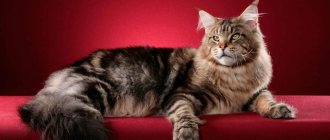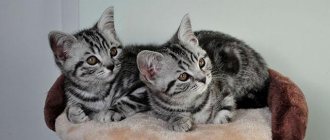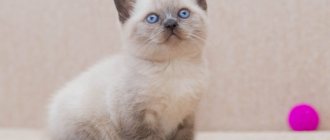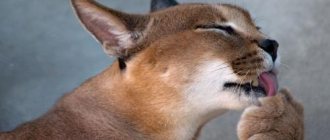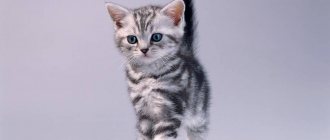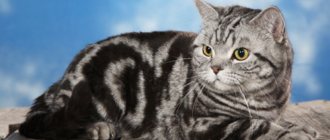Animal selection requires mandatory documentary confirmation. For ease of classification, felinology has adopted codes (encodings) for cat breeds and colors. Coding has general principles and indices.
The breed is designated by three capital English
letters.
The main color is in lowercase English letters
. Color group, eye color, ear shape, tail shape - in pairs of numbers. The encoding must be included in the documents on the breeding origin of the animal (pedigree, metrics). The order of numbers may differ in different felinological systems.
XXX xx NN NN NN (NN)
XXX
– breed code;
xx
– coding of the main color;
NN
– digital designation of color, eye color, ear shape, etc.
In the IFA system, the arrangement of numbers in a color is accepted according to its name, for example, the color “black silver marbled bicolor with yellow eyes” - ns 22 03 62
(
n
– black,
s
– silver,
22
– marbled,
03
– bicolor,
62
– orange/yellow eye color).
Numerical designation of colors (NN – in general coding)
- The number 0 begins to indicate the presence of white in color
- The number 1 begins to indicate the degree of tipping
- The designation of the design variant begins with the number 2
- The number 3 begins to indicate the point color variant
- The number 5 begins to indicate the length of the tail (not always indicated)
- The number 6 begins to indicate eye color (not always indicated)
- The number 7 begins to indicate the shape of the ears.
| White quantity coding (bicolor scheme) |
| 01 – harlequin |
| 02 – harlequin |
| 03 – bicolor |
| 09 – nonspecific white spots (“medallion”, “socks”) |
| Tipped color coding |
| 11 – closed |
| 22 – veiled (chinchilla, cameo) |
| Tabby pattern encoding |
| 21 – indeterminate tabby (for sphinxes, vans, harlequins, color-points) |
| 22 – marble |
| 23 – striped |
| 24 – spotted |
| 25 – ticked |
| Color point color coding |
| 31 – Burmese pointing |
| 32 – Tonkinese pointing |
| 33 – Siamese pointing |
| Tail length coding |
| 51 – tailless (only for the Manx breed) |
| 52 – short tail (for the bobtail breed) |
| 53 – pushed back bob |
| 54 – normal tail length |
| Eye color coding |
| 61 – blue eyes |
| 62 – orange eyes |
| 63 – differently colored eyes (necessarily one blue) |
| 64 – green eyes |
| 65 – Burmese eye color |
| 66 – Tonkinese eye color |
| 67 – Siamese eye color |
| Ear shape coding |
| 71 – straight |
| 72 – ears curled back (curl) |
| 73 – ears folded forward (fold) |
Colors
| a | blue, blue point (a 33) |
| b | chocolate, choclit point (b 33) |
| c | lilac, lilac point (c 33) |
| d | red, red point (d 33) |
| e | cream, cream point (e 33) |
| f | black tortoiseshell, tortie point (f 33) |
| g | blue-cream, blue cake point (g 33) |
| h | chocolate tortoiseshell, choclit torty point (h 33) |
| j | lilac tortoiseshell, lilac tortie point (j 33) |
| n | black, seal point (n 33), ebony (for orientals) |
| o | sorrel, cinnamon |
| p | beige background |
| q | tortoiseshell sorrel |
| r | tortoiseshell, beige background |
| s | smoky, silver |
| w | white |
| y | gold |
| x | unrecognized color |
Black smoke
This color occurs if the cat’s hair is colored in two colors: the lower part is white, and the upper part is dark. Sometimes the pigmentation of the hairs on the body has different intensity, then the effect of iridescent fur appears on the animal’s fur coat. Black Smoke Maines are often born with light spots due to genetic predisposition, so even dark and smoky fur types are rare.
Tabby (Tabbies)
If your cat has stripes on his coat, then the color of this Maine Coon is called “tabby” or “brindle”. All tabbies have thin lines on their muzzle that expressively outline their eyes, and on their forehead lines that form the letter “M.” If you look at the fur close up, you will notice that each hair is colored with dark and light stripes. This alternation is called "Agouti". It is commonly believed that tabby is the original color of wild cats.
There are four main tabby patterns:
Mackerel tabby (brindle)
- a pattern in the form of parallel vertical stripes.
Classic tabby (classic)
- wide spiral stripes on the sides, reminiscent of marble stains. In the UK this pattern is called "blotched tabby".
Spotted tabby - (spotted).
Spots throughout the body in the form of intermittent stripes.
Ticked tabby
- sometimes called Abyssinian or agouti. Without stripes or spots on the body, but with a pattern on the face and agouti on the body. This color is typical for Abyssinian cats, but it also occurs in other cats. Ticked colors are not recognized in the Maine Coon breed.
Tabbies come in a wide variety of colors. Tabby color refers to the color of the stripes or the tip of the tail. The main color of agouti varies from faded blue to deep red.
Maine Coon cat, black silver tabby color ns 22
Maine Coon cat red silver tabby ds 22
Maine Coon cat, cream tabby color MCO e 22
Maine Coon cat color black tabby with white (black classic tabby with white) n 09 22
Maine Coon cat, black tabby color (black-classic-tabby) MCO n 22
Maine Coon cat brown mackerel tabby
Maine Coon cat color brown spotted with white (brown mackerel spotted / white) f 09 24
Maine Coon cat brown tabby color
White monochrome (solid)
This shade is rare for Maine Coon skin; it appears due to the complete absence of pigment, that is, albinism. Getting such individuals is fraught with dire consequences.
Along with their snow-white coat, cats run the risk of inheriting incurable and difficult-to-correct genetic diseases. Animals are often born with congenital problems such as deafness and blindness.
In essence, whiteness among Maines is the absence of color. However, healthy cats do not completely lose their coat pigmentation. Upon closer inspection, fuzzy spots are visible on the whitening fur coat - a shadow pattern that becomes paler with age.
Is it only cats?
There is a persistent myth that only cats can be carriers of tortoiseshell coloring - due to the fact that their sex chromosomes look like XX and make it possible for both black and red colors to appear simultaneously. It is not true. It is also not entirely true that, according to statistics, for every three thousand tortoiseshell cats, only one cat of this color is born - and that one is somehow sick, defective and practically sexless.
Tortoiseshell cat or tortoiseshell cat?
The quirks of nature are much more diverse and sophisticated than our understanding. Genetic solitaire games sometimes produce unpredictable results that are difficult to explain from a scientific point of view. For example, felinologists claim that the birth rate of tricolor cats directly depends on the region of their residence - scientists have not yet found an explanation for this phenomenon. But statistics on this matter, alas, are inaccurate—systematic studies have not yet been conducted.
Tortoiseshell cats
Contrary to popular belief, tortoiseshell - calico - cats do exist. But in order for the “female” color to appear, the cat must have a certain gene anomaly: the formula of their sex chromosome set is XXY. Such males are usually sterile, although there are exceptions.
Quite a lot of tricolor chimera cats are known. They can be anatomically and behaviorally similar to cats, practically do not mark their territory, do not react to females in heat and, accordingly, do not give birth to offspring. Calico-colored cats are more common than “tortoises”; they are usually cryptorchids - but that’s a completely different story.
Since the nineteenth century, felinologists from different countries have described many tricolor cats. Unfortunately, most of them were not only sterile, but also did not live long, since along with the genetic mutation they received various serious diseases.
Blue marble
Blue kittens range in shades from slate gray to light blue, giving each cat a unique look. Rich blue stripes on a lighter coat look impressive. There are individuals whose hairs are colored in three colors at once: white - blue - gray. With such a wealth of colors, the cat's coat looks shimmering and smooth. Unlike merle, this color was obtained through painstaking breeding by breeders.
Black marble
This kind of marble was not bred by specialists, but appeared along with the rock. Wide dark stripes and brown fur helped the animals hide in the forest when hunting. The shade was called marble because when transitioning from one strip to another, the feeling of a stone surface is created. Representatives with marbled fur coats are often larger than their respectable relatives, because their appearance has remained virtually unchanged since the birth of the Maines.
Red single color (solid)
In fact, redness implies rich terracotta or cream shades of fur without light tan marks or a smoky effect. Each hair must be completely dyed. In the place where the patterns are located on the fur, the shade is 2-3 times stronger. The coat of this color is always accompanied by a pattern, so Maines do not have uniform redness.
To read: Tiny Spitz: characteristics of the breed, caring for a cute pet
Character of British pets
Representatives of the British breed belong to the category of pets with a difficult character.
- Sociable, but do not allow familiarity. You can pick up a British cat only if she is currently in the mood for it. Any violence or action against the will is regarded as an insult. The cat may proudly walk away, or it may bite.
- The Briton is not prone to active group games. He will most likely stay in a safe place and look down on all the fun.
- Very persistent in expressing their own demands. There are times when cats of this breed do not eat for a long time just because they want to change the place for their bowl.
There is a tendency towards aggression in the behavior of British Shorthairs. But it is never groundless. If the cat does not feel discomfort, then it will not terrorize the household with its bad inclinations.

